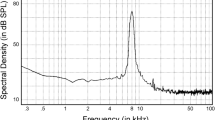Summary
The tympanate, arctiid moth,Cycnia tenera responds to pulsed, 30 kHz acoustic stimuli resembling bat echolocation signals by emitting trains of clicks. This phonoresponse was used to determine that this moth is maximally sensitive to stimulus pulse repetition rates of 30–50 pulses/s, rates typically emitted by bats shortly before they close with their targets. At rates both above and below this optimum moths exhibit higher thresholds and reduced responsiveness. These data suggest thatC. tenera is capable of using the repetition rate emitted by an approaching bat as a cue in determining the relative proximity of the bat. The use of repetition rate information should allow this moth both an unambiguous indication of a bat at very close range as well as the ability to distinguish sources of nocturnal, high-frequency sounds not emitted by predators.
Similar content being viewed by others
References
Dunning DC, Roeder KD (1965) Moth sounds and the insect-catching behavior of bats. Science 147:173–147
Fenton MB, Fullard JH (1979) The influence of moth hearing on bat echolocation strategies. J Comp Physiol 132:77–86
Fullard JH (1979) Behavioral analyses of the auditory sensitivity inCycnia tenera Hübner (Lepidoptera: Arctiidae). J Comp Physiol 129:79–83
Fullard JH (1982) Cephalic influences on the defensive behavior in the dogbane tiger moth. Physiol Entomol 7:181–186
Fullard JH, Fenton MB (1977) Acoustic and behavioural analyses of the sounds produced by some species of Nearctic Arctiidae (Lepidoptera). Can J Zool 55:1213–1224
Fullard JH, Fenton MB, Simmons JA (1979) Jamming bat echolocation: the clicks of arctiid moths. Can J Zool 57:647–649
Fullard JH, Fenton MB, Furlonger CL (1983) Sensory relationships of moths and bats sampled from two Nearctic sites. Can J Zool 61:1752–1757
Griffin DR (1958) Listening in the dark. Yale University Press, New Haven, Connecticut. (Reprinted by Dover Publications, New York, 1974)
Jen PH-S, Kamada T (1982) Analysis of orientation signals emitted by the CF-FM bat,Pteronotus p. parnellii and the FM bat,Eptesicus fuscus during avoidance of moving and stationary obstacles. J Comp Physiol 148:389–398
Miller LA, Olesen J (1979) Avoidance behavior in green lacewings I. Behavior of free-flying green lacewings to hunting bats and ultrasound. J Comp Physiol 131:113–120
Novick A (1977) Acoustic orientation. In: Wimsatt WA (ed) Biology of bats, vol 3. Academic Press, New York, pp 73–287
Morris GK, Fullard JH (1983) Random noise and congeneric discrimination inConocephalus (Orthoptera: Tettigoniidae). In: Orthopteran mating systems. Westview Press, Boulder, pp 73–96
Roeder KD (1962) The behaviour of free-flying moths in the presence of artificial ultrasonic pulses. Anim Behav 10:300–304
Roeder KD (1967) Nerve cells and insect behavior. Harvard University Press, Cambridge, Massachusetts
Simmons JA, Fenton MB, O'Farrell MJ (1979) Echolocation and pursuit of prey by bats. Science 203:16–21
Webster FA, Brazier OB (1968) Experimental studies on location mechanisms in bats. Aerospace Medical Res Lab, Wright-Patterson Air Force Base, Ohio, AD 673373
Author information
Authors and Affiliations
Rights and permissions
About this article
Cite this article
Fullard, J.H. Listening for bats: pulse repetition rate as a cue for a defensive behavior inCycnia tenera (Lepidoptera:Arctiidae). J. Comp. Physiol. 154, 249–252 (1984). https://doi.org/10.1007/BF00604990
Accepted:
Issue Date:
DOI: https://doi.org/10.1007/BF00604990




